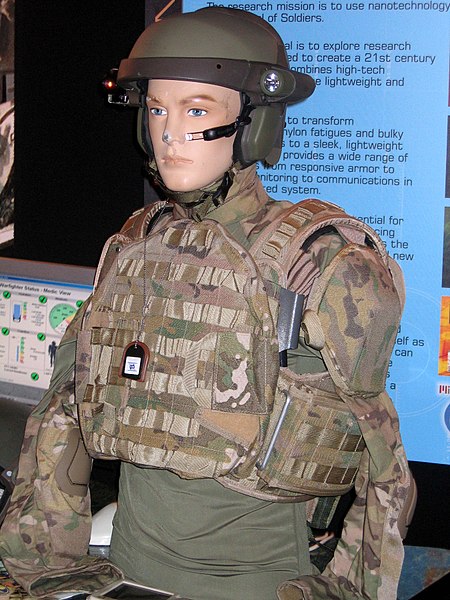MultiCam is a camouflage pattern designed for use in a wide range of environments and conditions which was specifically developed and is produced by American company Crye Precision. As a result of the pattern's effectiveness across disparate environments and regions, it has found extensive adoption globally. Variants of it, some unlicensed, are in use with armed forces worldwide, particularly with special operations units.
A mannequin wearing an early prototype of a MultiCam combat shirt in July 2004
A U.S. Army soldier at the U.S. Capitol in June 2005, modelling an early prototype MultiCam combat shirt at a military technology convention
U.S. Army Rangers of 3rd Battalion 75th Ranger Regiment wearing MultiCam while demonstrating the Future Force Warrior project at Fort Bliss, Texas, in February 2007
Australian special forces in MultiCam, June 2010
Military camouflage is the use of camouflage by an armed force to protect personnel and equipment from observation by enemy forces. In practice, this means applying colour and materials to military equipment of all kinds, including vehicles, ships, aircraft, gun positions and battledress, either to conceal it from observation (crypsis), or to make it appear as something else (mimicry). The French slang word camouflage came into common English usage during World War I when the concept of visual deception developed into an essential part of modern military tactics. In that war, long-range artillery and observation from the air combined to expand the field of fire, and camouflage was widely used to decrease the danger of being targeted or enable surprise. As such, military camouflage is a form of military deception in addition to cultural functions such as political identification.
Sniper wearing a ghillie suit
A-7D Corsairs in a disruptive pattern, countershaded with white, on a disruptively painted surface, Thailand, 1972.
A Ferret armoured car with "Berlin camouflage" meant to hide it against that city's concrete buildings. Such terrain-specific patterns are rare.
Croatian army uniform (right) had by 2008 diverged from the former Yugoslavian army pattern, apparently for cultural reasons such as political identification.








